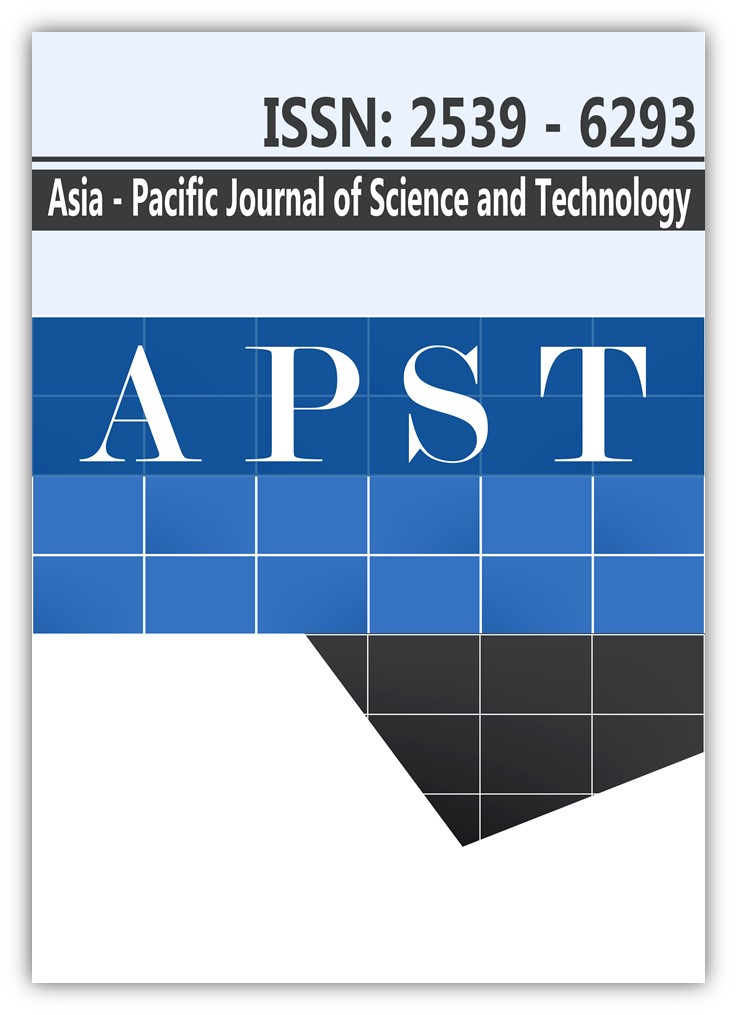Natural curing of fermented sausage using vegetable powders
Main Article Content
Abstract
Fermented sausages contain a unique flavor derived from lactic acid, which is generated by microorganisms. In order to produce the desired color, the addition of nitrite, which is used as a curing agent, is important. However, there is considerable carcinogenic potential. However, naturally curing agents may be more acceptable, and green vegetables also have potential. Therefore, 3 types of powder from indigenous vegetables (Alliumcepa var. aggregatum, AA/ Coriandrum sativum, CS/ Allium sativum L., AS) were prepared using vacuum drying at 60 ˚C. These powders were added to the ground sausage recipe at 0.1 % prior to fermenting at 4 ˚C for 24 h and at 37 ˚C for 24 h. The results showed that the pH and acidity values of all the sausages had not differed, suggesting typical fermentation. The redness values of the samples with vegetable powders were higher than those of the control (without adding nitrite), which indicates natural curing. Although no external nitrite was added, this result was concomitant with higher nitrite levels. In addition, the total plate count suggested that the addition of AS powder had inhibited microbial growth, while the growth of lactic acid bacteria had been promoted. The sensory evaluation revealed that regardless of the type of vegetable powder used, all sausages had been comparably acceptable. Therefore, AS powder may have the potential of becoming a natural curing agent in the production of fermented sausages.
Article Details
References
Skibsted LH. Nitric oxide and quality and safety of muscle based foods. Nitric Oxide. 2011;24:176-183.
Sindelar J, Milkowski A. Sodium nitrite in processed meat and poultry meats: a review of curing and examining the risk/ benefit of its use. AMSA White Paper Series. 2011;3:1-14.
General standard for food additives. CODEX STAN 192-1995. Adopted 1995, Revision 2016. p. 1-169.
Alahakoon AU, Jayasena DD, Ramachandra S, Jo C. Alternative to nitrite in processed meat: up to date. Trends Food Sci Technol. 2015;45:37-49.
Bahadoran Z, Mirmiran P, Jeddi S, Azizi F, Ghasemi A, Hadaegh F. Nitrate and nitrite content of vegetables, fruits, grains, legumes, dairy products, meats and processed meats. J Food Compost Anal. 2016;51:90-105.
Jin SK, Choi JS, Yang HS, Park TS, Yim DG. Natural curing agents as nitrite alternatives and their effects on the physicochemical, microbiological properties and sensory evaluation of sausage during storage. Meat Sci. 2018;146:34-40.
Toukalas DS, Katsanidis E, Marantidou S, Bloukas JG. Effect of freeze-dried leek powder (FDLP) and nitrite level on processing and quality characteristic of fermented sausages. Meat Sci. 2011;87:140-145.
Sindelar JJ, Cordray JC, Sebranek JG. Love JA, Ahn DU. Effect of varying levels of vegetable juice powder and incubation time on color, residual nitrate and nitrite, pigment, pH and trained sensory attributes of ready-to-eat uncured ham. J Food Sci. 2007;72:388-395.
Posthuma JA, Rasmussen FD, Sullivan GA. Effects of nitrite source, reducing compounds, and holding time on cured color development in a cured meat model system. LWT. 2018;95:47-50.
Maere HD, Fraeye I, Mey ED, Dewulf L, Michaels C, Paelinck H, et al. Formation of naturally occurring pigments during the production of nitrite-free dry fermented sausages. Meat Sci. 2016;114:1-7.
Zhang X, Li Y, Li B, Mao Y, Wu X, Zou X. Three supplementary methods for analyzing cytotoxicity of Escherichia coli O157:H7. J Microbiol Methods. 2016;120:34-40.
Curtis H, Noll U, Stormann J, Slusarenko AJ. Broad-spectrum activity of the volatile phytoanticipin allicin in extracts of garlic (Allium sativum L.) against plant pathogenic bacteria, fungi and oomycetes. Physiol Mol Plant Pathol. 2004;65:79-89.
Atsamnia D, Hamadache M, Hanini S, Benkortbi O, Oukrif D. Prediction of the antibacterial activity of garlic extract on E. coli, S. aureus, B. subtilis by determining the diameter of the inhibition zones using artificial neural networks. LWT. 2017;82:287-295.
Hospital XF, Carballo J, Fernandez M, Arnau J, Gratacos M, Hierro E. Technological implications of reducing nitrate and nitrite levels in dry-fermented sausages: typical microbiota, residual nitrate and nitrite and volatile profile. Food Control. 2015; 57:275-281.
Riel G, Boulaaba A, Popp J, Klein G. Effects of parsley extract powder as alternative for the direct addition of sodium nitrite in the production of mortadella-type sausage-impact on microbiological, physical and sensory aspects. Meat Sci. 2017;131:166-175.


